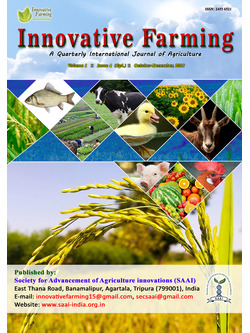
Entomopathogenic Fungi: A Potential Biocontrol Agent in Insect Pest Management
Arka Samanta
Dept. of Agricultural Entomology, Faculty of Agriculture, Bidhan Chandra Krishi Viswavidyalaya, Mohanpur, Nadia, West Bengal - 741252, INDIA
Koushik Sen*
Dept. of Agricultural Entomology, Faculty of Agriculture, Bidhan Chandra Krishi Viswavidyalaya, Mohanpur, Nadia, West Bengal - 741252, INDIA
DOI: NIL
Keywords: Biopesticides, Entomopathogenic fungi, Biological control, Pathogenicity, Virulence
Abstract
Application of synthetic insecticides resultant insect pest control is the primary means of crop protection in conventional agriculture all over the world. Indiscriminate uses of chemical pesticides at frequent intervals leads to insecticide resistance, pest resurgence, toxic residues in the environment and depletion of natural enemy population causing environmental pollution and severe health hazards. Biopesticides are considered to be the best alternative to synthetic pesticides that are highly effective, target specific and reduce environmental risks. Biopesticides are pesticides derived from natural materials such as animals, plants, bacteria, fungi, algae, viruses, nematodes and protozoa and minerals. Global biopesticides market is estimated to reach $4 billion by 2024, growing at a CAGR of 8.8% between 2016 and 2024. However, biopesticides may represent about 4.2% of the overall pesticides market in India. Globally, biopesticides production is 4.5% and in USA it is 6%, whereas in India, it accounts only 3% of the total chemical pesticides production. Entomopathogenic fungi identified as a promising biocontrol agent in the regulation of insect pest population without harming the non-target insects. Over 800 species of entomopathogenic fungi and 1000 species of protozoa pathogenic have been described and identified. Most research on entomopathogenic fungi has been aimed at developing them as inundative biological control agents of insects, mites and ticks, despite the great potential for use in conservation and classical biocontrol strategies. In the present article efforts will be made to draw attention and sound knowledge on the basics of use of entomopathogenic fungi in eco-friendly insect pest management.
Downloads
not found
Reference
Faria, M. R., & Wraight, S. P. 2007. Mycoinsecticides and mycoacaricides: A comprehensive list with worldwide coverage and international classification of formulation types. Biological Control, 43: 237–256.
Gilbert, L. I., & Gill, S. S. 2010. Insect control: biological and synthetic agents. Academic Press, Elsevier, London, pp. 1–5.
Shahid, A. A., Rao, A. Q., Bakhsh, A., & Husnain, T. 2012. Entomopathogenic fungi as biological controllers: New insights into their virulence and pathogenicity. Archives of Biological Science, Belgrade, 64(1): 21–42.
